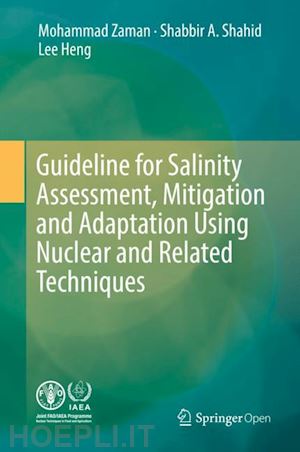
Questo prodotto usufruisce delle SPEDIZIONI GRATIS
selezionando l'opzione Corriere Veloce in fase di ordine.
Pagabile anche con Carta della cultura giovani e del merito, 18App Bonus Cultura e Carta del Docente
Chapter – 1: Introduction to Soil Salinity, Sodicity and Diagnostics Techniques.- Chapter – 2: Soil Salinity: Historical Perspectives and a World Overview of the Problem.- Chapter – 3: Salinity and Sodicity Adaptation and Mitigation Options.- Chapter – 4: Irrigation Systems and Zones of Salinity Development.- Chapter – 5: Irrigation Water Quality.- Chapter – 6: The role of Nuclear Techniques in Saline Agriculture.
Mohamed Zaman completed a PhD degree at Lincoln University, Canterbury, New Zealand on soil nitrogen (N) mineralization and its relationship to soil microbial and enzyme activity in grasslands under different management practices. After completing his PhD, Zaman continued postdoctoral research at Lincoln University in the areas of soil fertility and soil water quality, using both conventional and stable isotopic techniques. He then moved to Japan and worked with researchers from Chiba University, Chiba Prefecture Agricultural Research Station and the University of Tokyo on N dynamics and greenhouse gas emissions from upland soils using 15N as an isotopic trace. After two years in Japan, Zaman went back to New Zealand to take up a position as a researcher in the National Institute of Water & Atmospheric Research (NIWA), Hamilton. He then moved to the farmer owned cooperative fertilizer Industry, firstly as a Senior Scientist (5 years) and then as a Research Manager (4 years) to increase the adaptive capabilities of soil/plant systems to climate change and to enhance nutrient use efficiency on farms. This research included mitigating greenhouse gas (GHG) emissions in an integrated plant animal system, developing new decision support systems and tools, identifying novel products to increase farm productivity and resource use efficiency, and minimizing nutrient losses to waterways and the atmosphere. During this 9 year period at the Fertilizer Industry and the farming community, Zaman established an international network of academic researchers from New Zealand, Australia, Canada, China, Japan, Pakistan and USA to investigate fertilizer management techniques to increase nutrient use efficiency on farm and to mitigate greenhouse gas emissions.
Lee Kheng Heng has a PhD in soil science from Massey University and has more than 25 years’ experience in soil-plant-water interactions, agricultural water management and water use efficiency, integrated nutrient-water interactions and diffuse pollution control for sustainable agricultural production systems, at both national and international levels. Her work span over Africa, Asia, Europe, Central and Latin America on sustainable land and water management for climate smart agriculture and the efficient use and conservation of agricultural resources for enhancing food production and environmental sustainability.
Over the past 18 years, Dr Heng works at the Soil and Water Management & Crop Nutrition (SWMCN) Subprogramme, in the Joint FAO/ IAEA Division of Nuclear Techniques in Food and Agriculture. Currently she is the Head of SWMCN Subprogramme which assists scientists in Member States in the development, validation and dissemination of a range of soil, water and crop management technology packages through the use of nuclear and nuclear-related techniques.
Dr Heng currently is leading a coordinated research project on ‘Landscape Salinity and Water Management for Improving Agricultural Water Productivity’, to identify ways to improve crop productivity and sustainability through water and salinity management and to define approaches and technologies to assess and monitor soil water content and salinity at field and area-wide scales, to reduce the impacts of climate change and variability on the widespread increase in landscape water and soil salinity on food production.
Prior to her current assignment with the Joint FAO/IAEA Division, Dr Heng worked as a research associate in the Department of Agriculture and Forestry at The University of Melbourne, Australia. Her work involved measurement and modelling the transport of reactive solutes in soils, conducting field study on soil water and nitrogen dynamics under temperate pastures. She also worked with Landcare Research in New Zealand.
Shabbir Ahmad Shahid is Senior Salinity Management Scientist at the International Center for Biosaline Agriculture (ICBA), Dubai, UAE. Prior to joining the Center, he had served in different capacities in a number of organizations, including Associate Professor of Soil Science at the University of Agriculture, Faisalabad, Pakistan, Associate Research Scientist at the Kuwait Institute for Scientific Research, Manager of Soil Resources Department at the Environment Agency – Abu Dhabi, UAE. Overall, he has more than 36 years of experience in applied agricultural research in many countries and regions.Shabbir holds a PhD in soil micromorphology of salt affected soils from Bangor University, Wales, UK. He is author and coauthor of over 160 research publications, including six edited books published by Springer, author of three books and two manuals, 52 peer reviewed journal papers, 31 book chapters, 27 conference proceedings and other articles published in scientific magazines and newsletters. He also authored and coauthored over 30 scientific reports. H











Il sito utilizza cookie ed altri strumenti di tracciamento che raccolgono informazioni dal dispositivo dell’utente. Oltre ai cookie tecnici ed analitici aggregati, strettamente necessari per il funzionamento di questo sito web, previo consenso dell’utente possono essere installati cookie di profilazione e marketing e cookie dei social media. Cliccando su “Accetto tutti i cookie” saranno attivate tutte le categorie di cookie. Per accettare solo deterninate categorie di cookie, cliccare invece su “Impostazioni cookie”. Chiudendo il banner o continuando a navigare saranno installati solo cookie tecnici. Per maggiori dettagli, consultare la Cookie Policy.